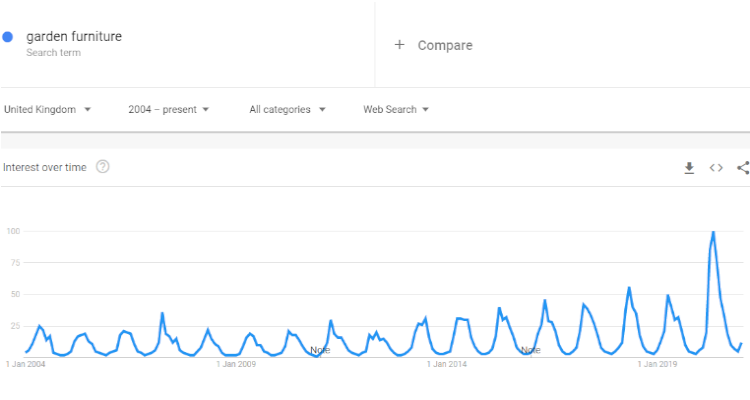Paid media channels all work in the same way. Within a certain budget you target as many audiences as you deem relevant, with relevant ads and a relevant landing page. Then you wait. Depending on the size of budget and audiences you’re probably looking at a 2 week wait at least. The reason for this is to start working towards your long-term goal. And that goal is to get maximum performance from your budget.
The key wording here is long-term. Typically, your worst month with paid media is your first month. Unless you’re a time traveler you can never know what targeting and setup will work best for you. Not even with intuitions and years of industry experience. It all comes down to trial and error. Test 5 things with an even share of budget and once they’ve all had a fair share of spend and time you can determine which 1 of those 5 areas works best for you. Then you provide that area with 100% of your budget. Optimisation simplified. But this is a long-term repetitive process of testing. There are so many areas within paid media that you can measure performance on and control your budget with.
So where do the other channels come in? Within some agency walls you will find a degree of isolation amongst the marketing channels. This is not by design, it is often just the nature of specialists focusing all their energy on what they’re best at. SEO specialists have their own platforms, methodology and practices. They have learned over many years how to get the best out of their data and research. The same is true for all areas within full-service agencies.
Everyone has a specialist role to play and they play it well. But what advantages do you gain by sharing data and research between departments? What are some specific ways that multiple teams can take truly actionable learnings from? See below for a list of ways this can be done:
Attribution reports:
We’ll start here with the most commonly used. The easiest way to look at this is taking a client with a high value service as an example. In this instance let’s imagine you’re working for a client that provides luxury holidays around the world. You’re going to be looking at revenue well over £500 for a single conversion. From the customers perspective that’s a considerably large financial decision. So, excluding the mindlessly rich, those customers are going to put considerable thought into it before grabbing their wallet. What does this equate to? A long customer journey with lots of back and forth.

A potential customer may be browsing their Facebook feed on a cold Monday commute to work and see a picturesque beach picture. Whether this is a paid Facebook ad or an organic post, that person isn’t going to start frantically fishing out their credit card. But they may make a mental note and bring it up with their partner over dinner that evening. But then the boiler repairs get brought up again and suddenly the beach gets forgotten. At least until the boiler gets repaired and payday comes back around. How does this look in the data?
Within Google Analytics, you can head to Conversions > Multi-Channel Funnels > Top Conversion Paths. Here you will find every variation of customer journey that has led to a conversion for you. This can tell you a long list of useful things. It can tell you which channels or campaigns or even keywords are contributing a large number of conversions to other areas despite not getting the conversion themselves. For example, a Display campaign may have spent over £1,000 for the month and seemingly had no conversions. But looking into attribution data you may find that it was often the first step on customer journeys that did lead to a conversion in another channel like organic or email.
Had that first step not been there then there’s an argument to say those conversions never happen. Multiple teams within an agency may be preparing their monthly reports to sit in a boardroom with a client and explain why, after a month of hard work, they’ve still delivered no conversions. However, should you look in attribution reports you have a better chance at proving your worth with concrete data.
Ad copy
Another huge part of ongoing optimisation within paid media is testing the ad copy. This will never end because it’s very difficult to predict what words and tone will work best in the moment. Best practice within paid is to rotate around 3 ads per keyword. Furthermore, it’s best to only test 1 small element within those 3 ads at any given time. A good example would be having the same descriptions and 2 headlines but testing variations of the third headline. With that third headline isolated you can determine that it was this that made the difference once you collect the results.
After a month of testing those 3 ads and after each of them getting an even share of the budget you will find that 1 of the ads had a significantly higher CTR and CVR. What does this tell you? That whatever headline you used to get that higher CTR and CVR should be considered in all marketing channels. Perhaps you’re running an email campaign alongside and wondering how to increase the open rate with a stronger subject heading. This is where the 2 teams can share their findings to provide data-driven ideas for the next test.
User profiling
Paid media channels function on more than just keyword targeting. There are several other ways that you can define the potential customer and adapt your budgets with. Those areas consist of the following:
• Location (As specific as a radius around a postcode)
• Demographics
• Time of day/week/month/year
• Device
• New vs returning
• Income
• Interests
• Parent or non-parent
• Milestones in their life
• Browsing habits
• Career attributes
There are even more ways in which you can profile and target your customers, but you get the idea. When running paid media channels, you’re collecting data on these areas and building up a stronger idea of your best possible customer. This helps you feed into the other channels when it comes to adapting their strategies. Whether that be the language they use, the design of the website or the purchase of stock. While all channels have profiling data to some degree, it seems as though paid media channels have the largest collection of unique signals you can use. And of course, don’t forget to share data from 1 paid media platform to another.
You may have the targeting capabilities in both but you’re not utilising them in both. Have a read through this article to learn more about the additional paid platforms you have at your disposal.
Search terms
One of the most similar channels to Google Search ads is SEO. Here you’re both fighting for the same space and the same searches. But there are differences. Most notably of which is that when it comes to performance data, SEO departments are no longer able to see data on specific searches. This has led to the most common of data sharing examples. Paid media providing SEO with data by search terms.
When SEO teams are looking to determine which searches are worth improving upon, it helps to know which searches lead to the most return. Paid media can do this by extracting data on specific searches that led to a conversion over a certain time period. Then, if both teams focus their time and energy on these searches, you can dominate that page with the top ad spot and top organic spot. Further increasing your CTR and CVR. Particularly on mobile where the result pages are smaller. There’s a really useful article here that explains how to approach keyword research in the best possible way.
Google Trends
Along the same lines as the above, you can help predict the future. Whatever the channel is, they’re all working to the same goal. To maximise performance. And while certain channels will be no stranger to Google Trends, there are some members who will be unfamiliar. Perhaps even the client when it comes to buying stock or affecting their expectations throughout the year. Particularly if this is a new venture.

Additionally, if you have been running paid media for several years you will have the annual patterns needed to predict the future. You will see in which seasons of the year that the product or service exceeds and at which times it goes quiet. Perhaps you’re looking at a retail client that gets the best performance over November and December. Or perhaps a garden furniture client that performs during the summer. The data will pinpoint these areas and help contribute to the larger scope with data-driven decisions. Telling the client to purchase enough stock to cope with the influx over Q4 or telling the dev teams that the best time to launch large scale changes to the site is perhaps over a weekend or January.
Free up your time with automation
This is where you work smarter not harder. While it’s admirable that some people in paid media stay up all night and all weekend changing bids and putting together reports, there are more effective ways to spend your time. An element of paid that other channels look onto with envy are the automation features. No doubt someone acting out a leafleting campaign would prefer to sit back while some ASIMO-inspired robot waddles from door-to-door.
This is where companies like Adzooma step in (not with leafleting robots). With Adzooma you will find a few different capabilities that will free up your time and allow you to focus on more complex areas that require creativity and human input. Such as the wider marketing strategy or writing effective ad copy. Or even spending time with your clients to build up the relationship and learn more about their business and what they’re hoping to achieve.
Adzooma lets you create automated rules to manage your spend and paid activity. It also provides you with a large number of ready-made reports that can pull in your data from multiple platforms ready to email over to clients. You can also cast an eye over general performance with all your accounts from multiple platforms in 1 neat little dashboard.
Affinity Audiences from Analytics
This is an often overlooked but highly effective way to learn more about the behavior of your customers. Within Google Analytics you can analyse performance data based on browsing habits and life events across your full marketing mix not just paid.
There are so many ways that Google will categorise these audiences for you that the best way to give you an example is to list out just some of the unique audiences available:
• Coffee Shop Regulars
• Green-living enthusiasts
• Comic-book readers
• Fitness buffs
• Family-oriented
• Choosing a primary school for their kids
• Recently started a new job
The list goes on. And all of these audiences allow you to report on CVR data or site engagement. Allowing you to build up your user profiling in finer detail. Reporting this to all marketing channels and the client will allow you to develop unique strategies and focus campaigns in more interesting ways. For example, working with coffee shops to have in-store displays or associating your business and website with eco-friendly living.
Conclusion
These are just some of the ways that PPC can benefit other channels and it doesn’t even cover the number of ways that other channels can boost PPC campaigns. So hopefully this addresses the potential benefits of multiple departments working together and a few specifics on how this can be done right now.
Here at Digital Discovery we’re a full-service agency that fully appreciates the need to co-ordinate all aspects of your marketing and website development to achieve maximum results.
If you’d like to have a chat with us to see if there’s anything, we can do to grow your business then don’t hesitate to get in touch on our website or take a look at our Adzooma Marketplace listing. Whether it’s a casual chat over a post-covid coffee or a late Friday afternoon pint over Zoom, we’re here to help.




